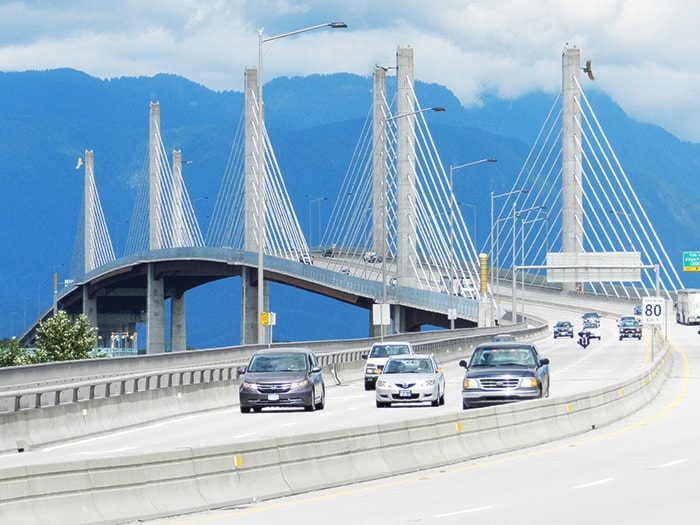Just when you got used to paying $6 to cross the Golden Ears Bridge there and back, the tolls are jumping again.
Starting July 15, the price for a transponder-equipped car jumps a nickel to $3.05, and by another dime to $6.10 for small trucks.
If you don’t have a transponder for your car and are not a registered video user, the toll goes up a nickel to $4.30.
The yearly increases aren’t causing Maple Ridge or Pitt Meadows residents to find another way to get to Surrey or Langley, said Sany Zein, director of infrastructure with TransLink.
“We don’t find the annual CPI adjustment is affecting the crossing over the bridge.”
Zein said the average number of daily crossings over the Fraser River, in both directions, is now 31,000.
Zein said that number, for the first six months of this year, is about four per cent higher than for the same period in 2013. In the last two years, the number of crossings has jumped a total of about six per cent.
“We’ve seen about 30 to 40 per cent total growth since we started on the bridge,” Zein said.
This July marks the fifth anniversary of the opening of the Golden Ears Bridge, an $808-million replacement for the Albion ferry that was shut down within weeks of the bridge opening.
Tolls charged on cars, trucks and motorcycles bring in about $39 million a year to TransLink, which is then paid to Golden Crossing General Partnership, owned by Bilfinger Berger, the construction company that built the bridge.
As well, TransLink pours in another $35-million to $40 million annually from its general revenues to Golden Crossing partnership to top up the payments.
The six-kilometre bridge will be paid off by 2041.
Zein said the numbers reflect a different reality after the great recession of 2008 changed the economic landscape and steep jumps in the price of gasoline cut back on the number of people driving over the bridge.
According to Statistics Canada, gasoline prices jumped from 86 cents a litre in 2004 to $1.21 a litre in 2008.
TransLink’s original projections, made around 2004, anticipated there would be 50,000 daily crossings of the bridge five years after it was built.
“When the Golden Ears Bridge opened in 2009, we were in a different economic reality,” Zein said.
But after reconfiguring forecasts in 2012, the numbers are more accurate.
Costs of running the bridge and using it are presented up front to users, he added.
The bridge was the first tolled structure in Metro Vancouver and has now been accepted by communities on both sides of the river as a user-pay model.
The Port Mann Bridge, which opened in 2012, is the second tolled structure.
Mayor Ernie Daykin said it may still be too early to predict the effects of the Golden Ears Bridge on his municipality’s development.
Ten years from now, analyzing the bridge’s effects might be easier. Daykin cited a restaurant owner who said he now gets customers from Surrey and Langley. Someone else he knows says he bought a nice home in Maple Ridge and said he’d pay bridge tolls for 20 years and still not make up the difference he’d have paid for a house in Surrey.
And it was always understood that toll revenues alone wouldn’t be enough to pay for the bridge, although TransLink didn’t expect they’d be as low as they are.
“We knew it was going to be a toll bridge from the get-go,” Daykin said.
He understood that no one wants to pay more.
“I get it, a nickel is a nickel.”
Without such regular increases, it will take longer to pay off the bridge.
He still says TransLink should try to offer fare discounts at off-peak times to draw more motorists. TransLink experimented with that briefly a few years ago, but the cheaper tolls didn’t bring increased use.
However, “Do it for six months to a year,” Daykin suggests.
And maybe motorists could buy monthly passes. Some motorists have to cross the bridge three or four times a day.
“I think 10 years from now … I think that it will continue to roll out to benefit Maple Ridge and Pitt Meadows.
“It has to. It just makes access that much easier.”
Daykin said he was willing to look at universal road tolls or mobility pricing, but only if TransLink’s property or gasoline taxes are scaled back in return.
